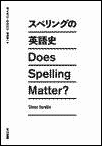2018-02-13 Tue
■ #3214. 1410年代から30年代にかけての Chancery English の萌芽 [standardisation][chancery_standard][reestablishment_of_english][monarch][hundred_years_war][spelling][koine]
1410年代から30年代にかけて,標準英語に直接つながっていくとされる Chancery English の萌芽が見出される.標準英語の形成を考える上で,無視することのできない重要な時期である.
英語の完全な復権と新しい標準変種の形成の潮流は,1413年に Henry IV がイングランド君主として初めて英語で遺書を残したことから始まる.1417年には玉璽局 (Signet Office) が Henry V の手紙を英語で発行し始めた.一方,1422年に,巷ではロンドンの醸造組合が会計上の言語として英語を採用するようになった.国会の議事録が英語で書かれるようになるのも,ほぼ同時期の1423年である.そして,1430年に,大法官庁が玉璽局の英語変種の流れを汲んで,East Midland 方言に基盤をもつコイネー (koine) を公的な書き言葉に採用したのである(Lancaster 朝の君主の英語使用については,「#1207. 英語の書き言葉の復権」 ([2012-08-16-1]) も参照).
この時代の潮流において,後に Chancery Standard と呼ばれることになる変種(の卵)を採用したのが,社会的影響力をもつ君主自身やその周辺であった点が大きい.Nevalainen and Tieken-Boon van Ostade (274) も次のように述べている.
Chancery English has a precursor in the form of English used by Henry V's Signet Office, the king's private secretariat which travelled with him on his foreign campaigns. It is significant that the selection of the variety which was to develop into what is generally referred to as the Chancery Standard originated with the king and his secretariat: the implementation of a standard variety can only be successful when it has institutional support.
もう1つ,Henry V が積極的に英語を使用した背景に,政治的な目論見があったのではないかという見解に注目すべきである (Nevalainen and Tieken-Boon van Ostade 274) .
. . . the case of Henry V possibly reflects not so much a decision made by an enlightened monarch and his council as political and practical motives: by writing in English, Henry first and foremost identified himself as an Englishman at war with France, while at the same time seeking to curry favour with the the English-speaking merchants, who might be prevailed upon to finance his campaigns.
1410年代から1430年代にかけての英語の公用化,さらには標準英語形成の背景には,社会的な力を巡る動きがおそらく関与していたと思われる.後の時代に標準的なものとして採用されていくことになる多くの綴字や形態が,上記のような政治性に彩られていた可能性があるということは知っておく必要があるだろう.
綴字からの例を挙げれば,light や knight にみられる <gh> の2重字 (digraph),過去(分詞)形の語尾として <t> ではなく <d> を用いる習慣,1人称単数代名詞にみられる I の大文字使用,その他 which, should, such, much, but, ask などは Chancery English の特徴を保持している.形態については,2人称単数代名詞としての ye/you,3人称複数代名詞としての they, them, their,再帰代名詞語尾としての self/selves,指示代名詞の複数形 those(tho の代わりに),副詞語尾の -ly(-liche の代わりに),過去分詞語尾の -n の使用や,動詞の現在複数の無語尾(-n 語尾の代わりに)など,多数挙げることができる.
・ Nevalainen, Terttu and Ingrid Tieken-Boon van Ostade. "Standardisation." Chapter 5 of A History of the English Language. Ed. Richard Hogg and David Denison. Cambridge: CUP, 2006. 271--311.
2018-01-29 Mon
■ #3199. 講座「スペリングでたどる英語の歴史」の第2回「英語初のアルファベット表記 --- 古英語のスペリング」 [slide][spelling][spelling_pronunciation_gap][oe_text][standardisation][runic][alphabet][grapheme][grammatology][punctuation][hel_education][link][asacul]
「#3139. 講座「スペリングでたどる英語の歴史」のお知らせ」 ([2017-11-30-1]) でお知らせしたように,朝日カルチャーセンター新宿教室で,5回にわたる講座「スペリングでたどる英語の歴史」が始まっています.1月27日(土)に開かれた第2回「英語初のアルファベット表記 --- 古英語のスペリング」で用いたスライド資料を,こちらに上げておきます.
今回は,アルファベットの系譜を確認しつつ,古英語がどのように表記され綴られいたかを紹介する内容でした.ポイントは以下の3点です.
・ 英語の書記はアルファベットの長い歴史の1支流としてある
・ 最古の英文はルーン文字で書かれていた
・ 発音とスペリングの間には当初から乖離がありつつも,後期古英語には緩い標準化が達成された
以下,スライドのページごとにリンクを張っておきます.多くのページに,本ブログ内へのさらなるリンクが貼られていますので,リンク集として使えると思います.
1. 講座『スペリングでたどる英語の歴史』第2回 英語初のアルファベット表記 --- 古英語のスペリング
2. 要点
3. (1) アルファベットの起源と発達 (#423)
4. アルファベットの系統図 (#1849)
5. アルファベットが子音文字として始まったことの余波
6. (2) 古英語のルーン文字
7. 分かち書きの成立
8. (3) 古英語のローマン・アルファベット使用の特徴
9. Cædmon's Hymn を読む (#2898)
10. 当初から存在した発音とスペリングの乖離
11. 後期古英語の「標準化」
12. 古英語スペリングの後世への影響
13. まとめ
14. 参考文献
2018-01-25 Thu
■ #3195. 講座「スペリングでたどる英語の歴史」の第1回「英語のスペリングの不規則性」 [slide][spelling][spelling_pronunciation_gap][hel_education][alphabet][grapheme][grammatology][link][asacul]
「#3139. 講座「スペリングでたどる英語の歴史」のお知らせ」 ([2017-11-30-1]) でお知らせしたように,朝日カルチャーセンター新宿教室で,5回にわたる講座「スペリングでたどる英語の歴史」が始まっています.1月13日(土)に第1回「英語のスペリングの不規則性」を終えましたが,その際に使用したスライド資料をこちらに公開しておきます.主たる参考文献として,Simon Horobin 著 Does Spelling Matter? (および私の拙訳書『スペリングの英語史』)を挙げておきます(「#3079. 拙訳『スペリングの英語史』が出版されました」 ([2017-10-01-1]) も参照).
あらためて本講座のねらいとメニューを明記しておきます.
多くの学習者にとって,英語のスペリングは,不規則で例外ばかりの暗記を強いる存在と映ります.なぜ knight や doubt というスペリングには,発音しない <k>, <gh>, <b> のような文字があるのでしょうか.なぜ color と colour,center と centre のような,不要とも思える代替スペリングがあるのでしょうか.しかし,不合理に思われるこれらのスペリングの各々にも,なぜそのようなスペリングになっているかという歴史的な理由が「誇張ではなく」100%存在するのです.本講座では,英語のたどってきた1500年以上の歴史を参照しながら,個々の単語のスペリングの「なぜ?」に納得のゆく説明を施します.講座を通じて,とりわけ次の3点に注目していきます.
1. 英語のスペリングの不規則性の理由
2. スペリングの「正しさ」とは何か
3. 「英語のスペリングは英語文化の歴史の結晶である」
5回にわたる本講座のメニューは以下の通りです.
第1回:英語のスペリングの不規則性
第2回:英語初のアルファベット表記 --- 古英語のスペリング
第3回:515通りの through --- 中英語のスペリング
第4回:doubt の <b> --- 近代英語のスペリング
第5回:color か colour か? --- アメリカのスペリング
第1回に配布した資料の目次は次の通りです.資料内からは hellog 内へのリンクも張り巡らせていますので,リンク集としても使えます.
1. 講座『スペリングでたどる英語の歴史』第1回 英語のスペリングの不規則性
2. 本講座のねらい
3. 第1回 「英語のスペリングの不規則性」の要点
4. (1) 英語のスペリングはどのくらい(不)規則的か
5. 発音とスペリングの「多対多」
6. (2) 文字の類型と歴史 (#422)
7. 言語と文字の歴史は浅い (#41)
8. 文字の系統 (#2398)
9. (3) 文字とスペリングの基本的性格
10. スペリングとは?
11. まとめ
12. 参考文献
・ Horobin, Simon. Does Spelling Matter? Oxford: OUP, 2013.
・ サイモン・ホロビン(著),堀田 隆一(訳) 『スペリングの英語史』 早川書房,2017年.
2018-01-12 Fri
■ #3182. ARCHER で colour と color の通時的英米差を調査 [ame_bre][spelling][archer][corpus][mode][webster]
意外と簡単にできる調査として,標題の例を紹介したい.近代英米語コーパス「#1802. ARCHER 3.2」 ([2014-04-03-1]) を用いて,綴字の英米差の通時的な調査を手軽に行える.例として,最も知られている <colour> と <color> の英米差を調べてみよう.
ARCHER Untagged にアクセスし,検索欄に "colour*" と "color*" 入れ,それぞれの結果を取り出す.それを「#1808. ARCHER 検索結果の時代×ジャンル仕分けツール (ARCHER Period-Genre Sorter)」 ([2014-04-09-1]) にかけて,自動的に4つの図表を作成させる.この図表により,両綴字の英米差について,1600--1999年を8区分した時代別に,そして12のジャンル別に比較することが可能となる.時代区分とジャンルは以下の通り.
・ P1 = 1600--49, P2 = 1650--99, P3 = 1700--49, P4 = 1750--99, P5 = 1800--49, P6 = 1850--99, P7 = 1900--49, P8 = 1950--99
・ a = advertising, d = drama, f = fiction, h = sermons, j = journals, l = legal, m = medicine, n = news, p = early prose, s = science, x = letters, y = diaries
では,まずイギリス英語からみていこう.上の図表が伝統的なイギリス式の <colour> の数値を示し,下が典型的にアメリカ式スペリングといわれる <color> の数値である.期待を裏切らず,イギリス英語では時代にかかわらず,ほぼ <colour> 一辺倒といってよい.
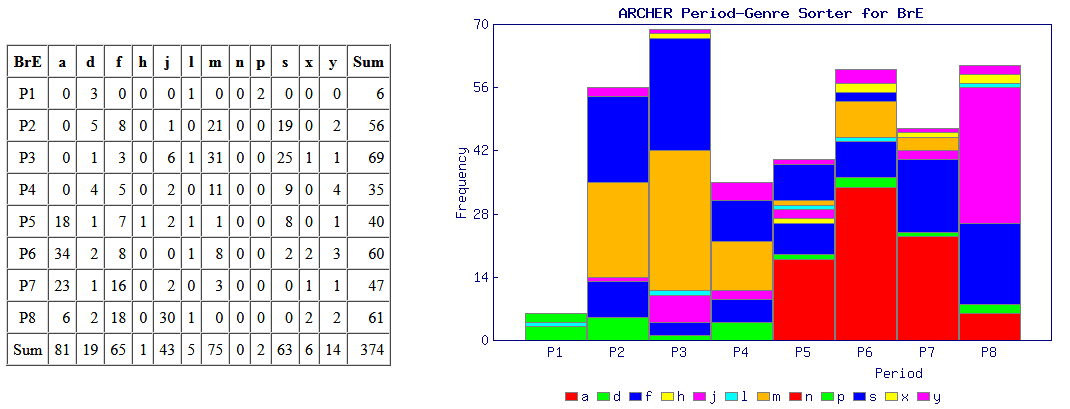
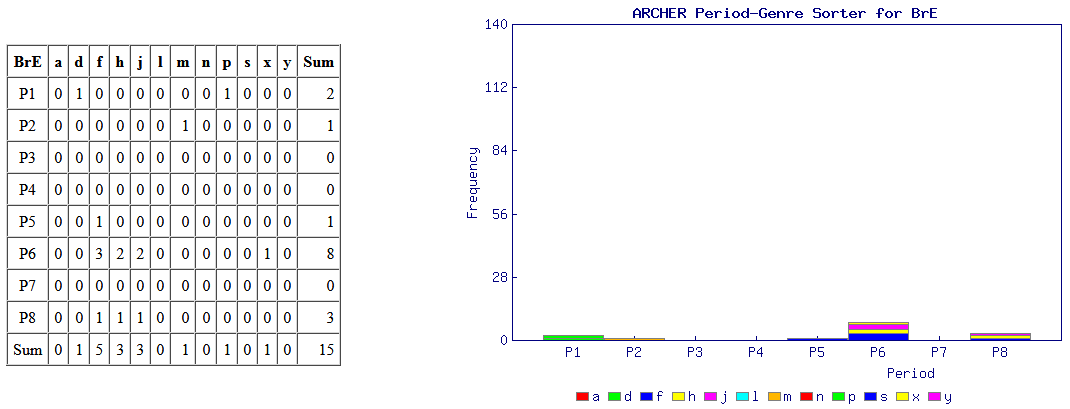
次にアメリカ英語の結果だが,こちらも英語史の期待を裏切らない.P4(1750--99年)までは伝統を受け継ぐ <colour> の綴字が圧倒的だが,P5 以降は著しく衰退し,代わりに <color> が伸びていく.P5 といえば,Noah Webster が An American Dictionary of the English Language を出版した1828年を含む半世紀の時代区分であり,米国式スペリングがその後数十年の時間をかけつつ定着していく様をよく表わしている.
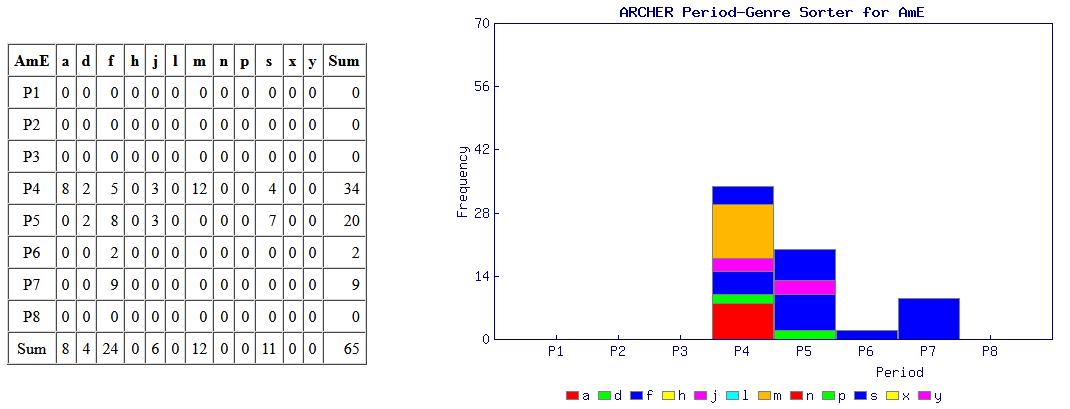
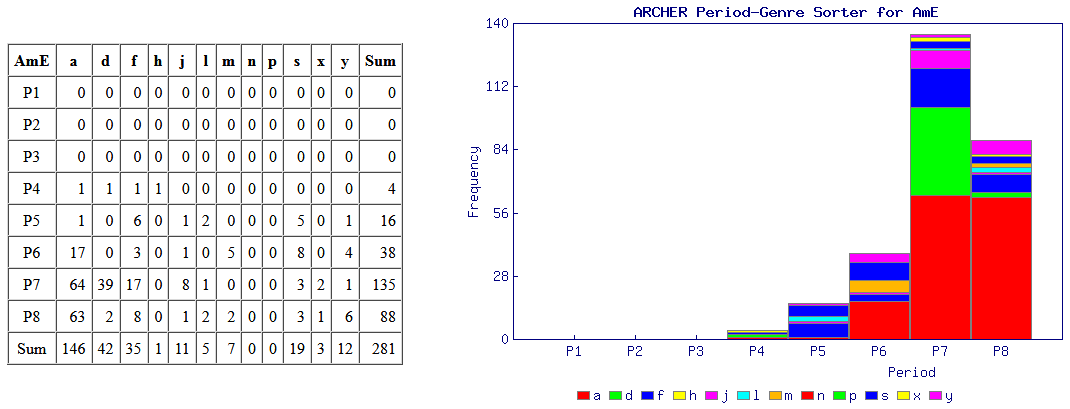
現在は超巨大な Google Books Ngram Viewer に簡単にアクセスできるため,ARCHER よりもさらに簡便に同じような調査を行えるようになっている.しかし,ARCHER ではコンコーダンス・ラインを引き出せるために文の中身を吟味することもできるし,ヒット件数が手作業でまかなえるほどに抑えられるというのも,考えようによっては利点といえる.要は使い方次第だ.ARCHER を使用した他の調査例として,「#1806. ARCHER で shew と show」 ([2014-04-07-1]),「#1807. ARCHER で between と betwixt」 ([2014-04-08-1]),「#1752. interpretor → interpreter (2)」 ([2014-02-12-1]) も参照.
2018-01-11 Thu
■ #3181. Spelling/Pronunciation Search [spelling][pronunciation][orthography][web_service][cgi][dictionary][spelling_pronunciation_gap][silent_letter]
「#1191. Pronunciation Search」 ([2012-07-31-1]) で,The Carnegie Mellon Pronouncing Dictionary に基づくアメリカ英語発音検索ツールを作成した.そのデータベース (3MB+) の実体は,110935対の綴字と発音の組み合わせである.前回のツールは,Carnegie Mellon Pronouncing Dictionary の発音表記を正規表現で指定して,それを含む単語の綴字を返すものだったが,今回は綴字と発音のそれぞれに正規表現で条件を指定し,いずれにもマッチする単語を返すという仕様のツールを作ってみた.
正規表現は Perl 用のもので,大文字・小文字の別は最初から無視する仕様.発音表記の凡例は,本記事の末尾に掲げておいた.どちらか一方の検索欄を空にすれば,純粋な綴字検索あるいは発音検索になる.
2018-01-04 Thu
■ #3174. 高頻度語はスペリングが短い (2) [frequency][spelling][orthography][zipfs_law][statistics][lexicology][corpus]
昨日の記事 ([2018-01-03-1]) と同じ頻度とスペリングの長さに関するデータを,もう少し分析してみた.以下は,頻度ランキングのトップ100語,200語,500語,1000語,2000語,5000語,10000語,20000語,50000語について,それぞれ最低値,第1四分位数,中央値,平均値,第3四分位数,最大値を示した表である.英語の正書法を論じる上での基礎データとしてどうぞ.
| Min. | 1st Qu. | Median | Mean | 3rd Qu. | Max. | |
|---|---|---|---|---|---|---|
| Top_100 | 1.0 | 2.0 | 3.0 | 3.1 | 4.0 | 5.0 |
| Top_200 | 1.00 | 3.00 | 4.00 | 3.77 | 4.00 | 10.00 |
| Top_500 | 1.000 | 4.000 | 4.000 | 4.498 | 5.000 | 10.000 |
| Top_1K | 1.000 | 4.000 | 5.000 | 4.968 | 6.000 | 15.000 |
| Top_2K | 1.000 | 4.000 | 5.000 | 5.406 | 7.000 | 15.000 |
| Top_5K | 1.000 | 5.000 | 6.000 | 6.014 | 7.000 | 16.000 |
| Top_10K | 1.000 | 5.000 | 6.000 | 6.488 | 8.000 | 16.000 |
| Top_20K | 1.000 | 5.000 | 7.000 | 6.954 | 8.000 | 17.000 |
| Top_50K | 1.000 | 6.000 | 7.000 | 7.622 | 9.000 | 20.000 |
これをもとに視覚化したのが,以下の箱ひげ図.
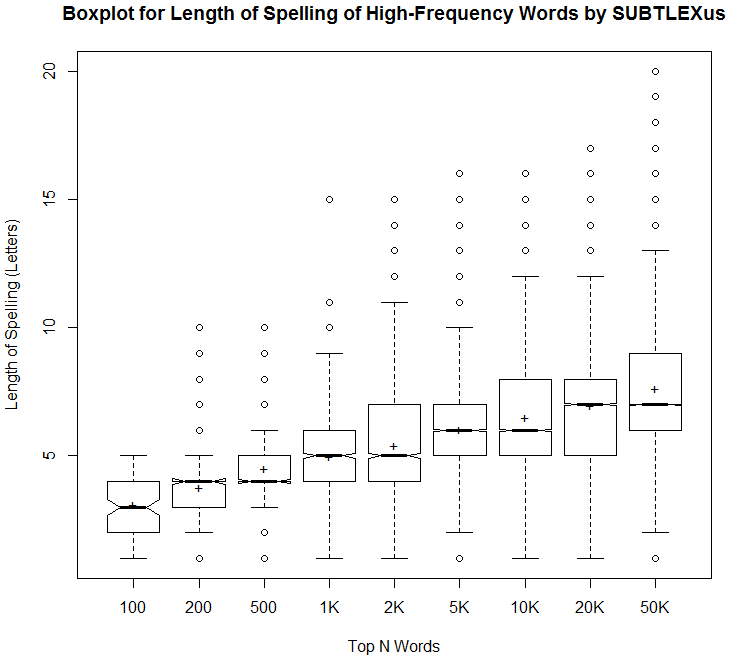
当然予想されたことだが,語数が増えるにしたがってスペリングの平均の長さは徐々に大きくなっていき,バラツキも広がっていく.しかし,トップ数万語でみても平均して7文字程度となっており,さほど長くないのだなという印象を受けた.
[ 固定リンク | 印刷用ページ ]
2018-01-03 Wed
■ #3173. 高頻度語はスペリングが短い (1) [frequency][spelling][orthography][zipfs_law][statistics][lexicology][corpus][three-letter_rule]
標題は特に目新しい指摘ではなく,英語を読み書きする者には直感されていることだと思われる.「#1091. 言語の余剰性,頻度,費用」 ([2012-04-22-1]) や「#1102. Zipf's law と語の新陳代謝」 ([2012-05-03-1]) でも指摘したように,よく読み書きする単語のスペリングは短いほうが効率がよいと考えられるからだ.逆に,滅多に読み書きしない単語であれば少々長くても我慢できる.単語のスペリングに限らず,単語の音形についても同様の原理が作用していると思われる.
また,英語の正書法には内容語は3文字以上で綴られなければならないという「#2235. 3文字規則」 ([2015-06-10-1]) がある.これは機能語という頻度のきわめて高い語類については適用されない.したがって,この規則は上記の効率の問題とも関わる実用的な側面をもつといえる.
高頻度語であればあるほど,そのスペリングが平均的に短いことを示す方法の1つに,頻度ランキングのトップ100語,1000語,10000語などのリストに基づき,文字数別に単語を数え上げるというやり方がある.「#2096. SUBTLEX-US Word Frequency List」 ([2015-01-22-1]) から引き出した頻度ランキングを利用して,トップ100語,200語,500語,1000語,2000語,5000語,10000語,20000語,50000語について調査した.トップ100語のリストについては先の記事でリストを掲載している通りであり,なかには s, ll などコーパスの仕様に由来するとおぼしき怪しい「語」もあるが,結果の大勢には影響を及ぼさないだろう.
以下にグラフで整理した通り,結果は明白である(数値データはソースHTMLを参照).トップ100語の超高頻度語群では62.00%までが3文字以下のスペリングである.3文字以下の割合(下から3つ分のオレンジの帯まで)ということで比べていくと,トップ200語から50000語の調査結果まで,順に41.50%, 24.60%, 17.00%, 12.65%, 8.06%, 6.01%, 4.55%, 3.20%と目減りしていく.
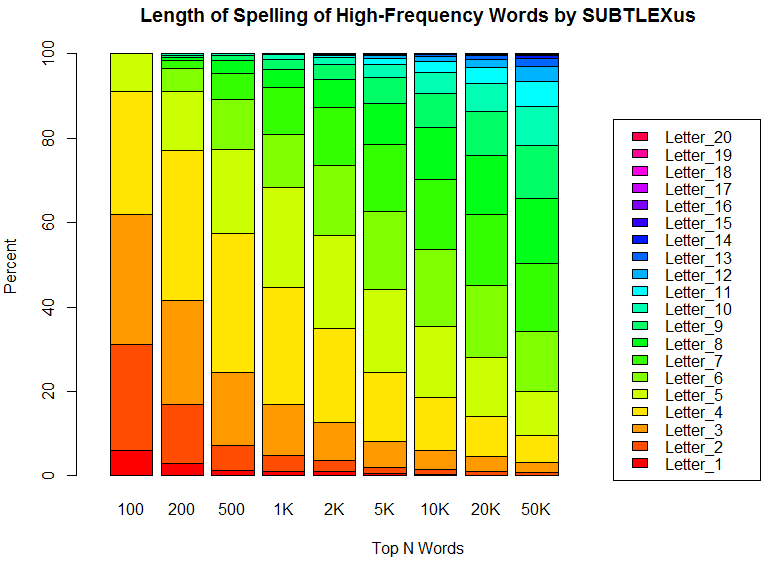
2017-12-02 Sat
■ #3141. 16世紀イングランドの識字率 [literacy][demography][spelling][standardisation]
「#3101. 初期近代英語期の識字率」 ([2017-10-23-1]),「#3066. 宗教改革と識字率」 ([2017-09-18-1]) に引き続いての話題.16世紀ヨーロッパでは教育制度がおおいに拡充され,文字を読み書きできる人々が多くなってきたことは確かだが,識字率として具体的な数字を与えることは難しい.都市と地方の差,階級差,男女差などが大きく,一般化することが困難であるばかりでなく,そもそも多くの統計や研究が誤った前提に立っているという事情がある.その前提とは,法的書類に署名できる人は文字を読むこともできたとするものだ.近年の脳科学の知見によれば,書くことと読むことはまったく別の行為であり,両者が常に連動するものと考えることはできない.
そこで,ペティグリー (317--19) は,様々な地域からの識字能力に関する断片的な情報を寄せ集めて,識字率を総合的に求めるという手法に訴えかけた.その結果として,以下の見解を導き出している.まず,都市と地方の識字率の差異については,言われるほど大きくなかったのではないかと述べている.人々は年と地方の間を頻繁に移動したし,彼らの集まる市場や酒場ではどこでも印刷物が貼り出されていたからだ.地方出身者であっても,文字を見慣れてはいただろう.
識字率の男女差については,差があっただろうとは想像できても,それが具体的に確かめられるような資料は乏しい.女性は高い識字能力が要求される仕事につくことはなかったために,記録としても残りにくいのである.それでも本を読み,楽しむ女性は多くいたようではある.
よく記録の残っている都市部の男性に限定すれば,高い識字率を誇る都市は印刷以前より存在した.16紀末のヴェネツィアでは33%ほどあったし,1530年のヨークでは20--25%ほどあった.このヨークの男性識字率は,同世紀末までには41%にまで跳ね上がっている.
16世紀,そして続く17世紀にイングランドの識字率が大幅に上昇したことは間違いない.教育の拡充,印刷の普及,その他の社会的要因がこの上昇に貢献しているが,これらの諸要因はまた英語の綴字の標準化にも間接的に寄与しているのである.いよいよ大衆が本格的に文字に接し始めたときに,標準的な綴字が求められるようになったのだろう.
・ ペティグリー,アンドルー(著),桑木 幸司(訳) 『印刷という革命 ルネサンスの本と日常生活』 白水社,2015年.
2017-11-30 Thu
■ #3139. 講座「スペリングでたどる英語の歴史」のお知らせ [notice][spelling][spelling_pronunciation_gap][hel_education][asacul][sobokunagimon]
来年2018年の1月から3月にかけて,朝日カルチャーセンター新宿教室にて5回にわたる講座「スペリングでたどる英語の歴史」を開講します.
このテーマを掲げたのは,去る9月に Simon Horobin 著 Does Spelling Matter? の拙訳書『スペリングの英語史』が出版されたこともありますし,先立つ4月に開講した「#2911. 英語史講座第1回「綴字と発音の関係を探る――なぜ doubt に <b> があるのか?」」 ([2017-04-16-1]) でも関心をもたれる方が多かったからです.そして,何よりもこのテーマは,英語史を通観するのにとても優れた視点なのです.スペリングの歴史を通じて,文字論はもとより音韻論,形態論,言語接触,社会言語学,語用論といった多様な角度から,英語史を概観することができます.関心のある方は,是非どうぞ.
関連して,拙著『英語の「なぜ?」に答える はじめての英語史』の「第2章 発音と綴字に関する素朴な疑問」,および拙著『英語史で解きほぐす英語の誤解 --- 納得して英語を学ぶために』の「第6章 英語は日本語と比べて文字体系が単純である」もご参照ください.
本講座の趣旨と各回で扱う予定の内容は次の通りです.
多くの学習者にとって,英語のスペリングは,不規則で例外ばかりの暗記を強いる存在と映ります.なぜ knight や doubt というスペリングには,発音しない <k>, <gh>, <b> のような文字があるのでしょうか.なぜ color と colour,center と centre のような,不要とも思える代替スペリングがあるのでしょうか.しかし,不合理に思われるこれらのスペリングの各々にも,なぜそのようなスペリングになっているかという歴史的な理由が「誇張ではなく」100%存在するのです.本講座では,英語のたどってきた1500年以上の歴史を参照しながら,個々の単語のスペリングの「なぜ?」に納得のゆく説明を施します.
1. 総論;アルファベットの起源と英語のスペリング
2. 英語初のアルファベット表記 --- 古英語のスペリング
3. 515通りの through --- 中英語のスペリング
4. doubt の <b> --- 近代英語のスペリング
5. color か colour か? --- アメリカのスペリング
英語のスペリングの理不尽さに「納得のゆく説明」を与えると述べていますが,これは「実用的で役に立つ説明」と同一ではありません.しかし,中長期的にみれば「納得のゆく説明」こそが重要であると考えています.
2017-11-12 Sun
■ #3121. 「印刷術の発明と英語」のまとめ [slide][printing][history][link][hel_education][emode][reformation][caxton][latin][standardisation][spelling][orthography][asacul]
英語史における印刷術の発明の意義について,スライド (HTML) にまとめてみました.こちらからどうぞ.結論は以下の通りです.
1. グーテンベルクによる印刷術の「改良」(「発明」ではなく)
2. 印刷術は,宗教改革と二人三脚で近代国語としての英語の台頭を後押しした
3. 印刷術は,綴字標準化にも一定の影響を与えた
詳細は各々のページをご覧ください.本ブログの記事や各種画像へのリンクも豊富に張っています.
1. 印刷術の発明と英語
2. 要点
3. (1) 印刷術の「発明」
4. 印刷術(と製紙法)の前史
5. 関連年表
6. Johannes Gutenberg (1400?--68)
7. William Caxton (1422?--91)
8. (2) 近代国語としての英語の誕生
9. 宗教改革と印刷術の二人三脚
10. 近代国語意識の芽生え
11. (3) 綴字標準化への貢献
12. 「印刷術の導入が綴字標準化を推進した」説への疑義
13. 綴字標準化はあくまで緩慢に進行した
14. まとめ
15. 参考文献
16. 補遺: Prologue to Eneydos (#337)
他の「まとめスライド」として,「#3058. 「英語史における黒死病の意義」のまとめスライド」 ([2017-09-10-1]),「#3068. 「宗教改革と英語史」のまとめスライド」 ([2017-09-20-1]),「#3089. 「アメリカ独立戦争と英語」のまとめスライド」 ([2017-10-11-1]),「#3102. 「キリスト教伝来と英語」のまとめスライド」 ([2017-10-24-1]),「#3107. 「ノルマン征服と英語」のまとめスライド」 ([2017-10-29-1]) もどうぞ.
2017-10-31 Tue
■ #3109. なぜ -(e)s の付け方と -ing の付け方が綴字において異なるのか? [suffix][spelling][sobokunagimon][3sp][plural][gerund][participle][grahotactics]
「#3106. なぜ -ed の付け方と -(e)s の付け方が綴字において異なるのか?」 ([2017-10-28-1]) に続いて,こちらも似ているようで完全には平行的でない,2つの屈折接辞の付け方に関する綴字問題.try について,-s は <y> を <ie> に変えた上で付加して tries とするが,-ing の付加はそのままで trying となる.そうかと思えば,die では,-s をそのまま付けて dies とするが,-ing は <ie> を <y> に変えた上で付けるので dying となる.一見不思議な,これらの反対向きの規則については,過去(分詞)の -ed と現在分詞・動名詞の -ing の話しを主としながら,「#3069. 連載第9回「なぜ try が tried となり,die が dying となるのか?」 ([2017-09-21-1]) で考えた.
Carney (73--74) は,現代英語綴字の本格的な研究書のなかで,McLead による綴字教育のための綴字規則を列挙している.そのうち -(e)s や -ing の付加と直接・間接に関与するものとして以下のものを挙げているので,引用しよう.
Rule VII --- Words ending in 'y' preceded by a vowel simply add 's'.
--- an adaptation rule, presumably to form the plural or 3rd pers. pres. sg.: boy -- boys, say -- says, employ -- employs.
. . . .
Rule IX --- If you want to add other letters to a word ending in 'y' preceded by a consonant change 'y' into 'i'.
--- an adaptation rule; it refers in effect to the corresponding <y>≡/aɪ/ (deny--denial); the restriction 'preceded by a consonant' is intended to rule out betray--betrayal, employ--employer. McLeod points out that it does not apply before <-ing> (denying)
Rule X -- 'i' before another 'i' becomes 'y'.
--- a graphotactic rule; presumably it refers in an oblique way to examples such as die--dying or carrying--carrier--carried; the recent loan-word skiing is an exception.
Rule XI --- Words ending in a hissing sound form their plural by adding 'es' instead of 's'.
--- this has the form of an adaptation rule. It is a recognition that <s>, unlike the <ed> of the past tense, does not represent all the allomorphs /s/, /z/ and /ɪz/ of the plural . . . .
上記は,-(e)s, -ed, -ing の付け方の規則を共時的に記述しているにすぎず,通時的な観点も含まれていなければ,なぜそうなのかを説明してもいない.「通時的な説明」こそが必要と思われるのだが,あまり見たことがないので,おいおい考えていきたい問題である.
・ Carney, Edward. A Survey of English Spelling. Abingdon: Routledge, 1994.
・ McLeod, M. E. "Rules in the Teaching of Spelling." Studies in Spelling. Publications of the Scottish Council for Research In Education XL. Ed. H. J. L. Robbie. London: ULP,1961.
2017-10-30 Mon
■ #3108. ノルマン征服がなかったら,英語は・・・? [hel_education][history][loan_word][spelling][stress][rsr][gsr][rhyme][alliteration][gender][inflection][norman_conquest]
「#119. 英語を世界語にしたのはクマネズミか!?」 ([2009-08-24-1]) や「#3097. ヤツメウナギがいなかったら英語の復権は遅くなっていたか,早くなっていたか」 ([2017-10-19-1]) に続き,歴史の if を語る妄想シリーズ.ノルマン征服がなかったら,英語はどうなっていただろうか.
まず,語彙についていえば,フランス借用語(句)はずっと少なく,概ね現在のドイツ語のようにゲルマン系の語彙が多く残存していただろう.関連して,語形成もゲルマン語的な要素をもとにした複合や派生が主流であり続けたに違いない.フランス語ではなくとも諸言語からの語彙借用はそれなりになされたかもしれないが,現代英語の語彙が示すほどの多種多様な語種分布にはなっていなかった可能性が高い.
綴字についていえば,古英語ばりの hus (house) などが存続していた可能性があるし,その他 cild (child), cwic (quick), lufu (love) などの綴字も保たれていたかもしれない.書き言葉における見栄えは,現在のものと大きく異なっていただろうと想像される.<þ, ð, ƿ> などの古英語の文字も,近現代まで廃れずに残っていたのではないか (cf. 「#1329. 英語史における eth, thorn, <th> の盛衰」 ([2012-12-16-1]) や「#1330. 初期中英語における eth, thorn, <th> の盛衰」 ([2012-12-17-1])) .
発音については,音韻体系そのものが様変わりしたかどうかは疑わしいが,強勢パターンは現在と相当に異なっていたものになっていたろう.具体的にいえば,ゲルマン的な強勢パターン (Germanic Stress Rule; gsr) が幅広く保たれ,対するロマンス的な強勢パターン (Romance Stress Rule; rsr) はさほど展開しなかったろうと想像される.詩における脚韻 (rhyme) も一般化せず,古英語からの頭韻 (alliteration) が今なお幅を利かせていただろう.
文法に関しては,ノルマン征服とそれに伴うフランス語の影響がなかったら,英語は屈折に依拠する総合的な言語の性格を今ほど失ってはいなかったろう.古英語のような複雑な屈折を純粋に保ち続けていたとは考えられないが,少なくとも屈折の衰退は,現実よりも緩やかなものとなっていた可能性が高い.古英語にあった文法性は,いずれにせよ消滅していた可能性は高いが,その進行具合はやはり現実よりも緩やかだったに違いない.また,強変化動詞を含めた古英語的な「不規則な語形変化」も,ずっと広範に生き残っていたろう.これらは,ノルマン征服後のイングランド社会においてフランス語が上位の言語となり,英語が下位の言語となったことで,英語に遠心力が働き,言語の変化と多様化がほとんど阻害されることなく進行したという事実を裏からとらえた際の想像である.ノルマン征服がなかったら,英語はさほど自由に既定の言語変化の路線をたどることができなかったのではないか.
以上,「ノルマン征服がなかったら,英語は・・・?」を妄想してみた.実は,これは先週大学の演習において受講生みんなで行なった妄想である.遊び心から始めてみたのだが,歴史の因果関係を確認・整理するのに意外と有効な方法だとわかった.歴史の if は,むしろ思考を促してくれる.
2017-10-28 Sat
■ #3106. なぜ -ed の付け方と -(e)s の付け方が綴字において異なるのか? [suffix][spelling][sobokunagimon][3sp][plural]
動詞の過去(分詞)の接尾辞 {-ed} と,動詞の3単現あるいは名詞の複数の接尾辞 {-(e)s} とでは,綴字において付け方が異なる.およそ平行的に振る舞うかのように見えて,いろいろと細かな違いがある.Carney (18--19) が共時的な観点から,この問題に迫っているので,引用しよう.
. . . The past tense and participle morpheme {-ed} in regular verbs (ignoring forms such as spelt, spent, dreamt) has a constant <-ed> spelling in spite of the phonemic variation /ɪd/ (waited), /d/ (warned) and /t/ (watched).
There is very similar allomorphic variation in the noun plural and 3rd person present tense of the verb with its variants /ɪz/ (watches), /z/ (warns) and /s/ (waits). The two sets of phonetic variants are often cited together as equivalent examples of morphemic spelling. If we look closely at the details, however we find in fact that they are dealt with rather differently in the writing system (table 5).
Table 5 English plural and past tense inflections
{-ed} ending {-(e)s} ending 1 /-ɪd/ matted /-ɪz/ masses 2 /-ɪd/ mated /-ɪz/ maces 3 /-t/ hopped /-s/ (No *hoppes) 4 /-t/ hoped /-s/ hops, hopes 5 /-d/ planned /-z/ (No *plannes) 6 /-d/ planed /-z/ plans, planes 7 /-d/ hurried /-z/ hurries 8 /-d/ radioed /-z/ radios 9 /-d/ vetoed /-z/ vetoes, or vetos
Table 5 gives examples of each suffix in its three phonemic variants. The words provided as contexts include a preceding long vowel followed by a single consonant, a preceding short vowel followed by a single consonant, and the spelling variation found after <o>. The past tense has a constant <ed> spelling across all these contexts which is only varied by merging with a final <-e> in the long vowel words (e.g. hope -- hoped). The marking of the long vowels is also done indirectly by using <C>-doubling to mark a previous short vowel --- absence of doubling marks the long vowel. This is not done in the noun plural suffix, so there are no equivalents in rows 3 and 5 to <hopped> and <planned>, that is *<hoppes> and *<plannes>. Nor is there a variant spelling *<vetod> to spoil the uniformity of <-ed>. The <e> of <-oes> and <-ies> is best treated as a marker of the long vowel. Grammarians refer to the two inflections as the -s form and the -ed form and this is in accordance with the traditional spelling rule that one adds <-s> and <-ed> respectively to the base form.
If we try to use a consistent <-ed> morphemic spelling in chopping up words into correspondences without any overlap, this lack of symmetry becomes apparent. In scribbles we have /əl/≡<le> and in scribbled we have /əl/≡<l>; in hopes we have <e>-marking of the vowel as /əʊ/≡<o..e>, /p/≡<p>, /s/≡<s>, but in hoped we have /əʊ/≡<o>, /p/≡<p>, /t/≡<ed>, while the long vowel is marked by absence of <C>-doubling. In a process description, and indeed for any human speller, this is catered for by 'dovetailing' so that <hope>+<ed> becomes <hoped>, <eight>+<ty> becomes <eighty>, etc.
Carney は,綴字の原理は "a constant spelling for a morpheme" と "the varying pronunciation of the morpheme in different contexts" の間のバランスの上に成り立つものであり,それが個々の綴字(規則)のなかで複雑に配分されていることを示唆している.その配分の違いが,{-ed} と {-s} にも現われていると考えられる.しかし,なぜそうなのかについては,通時的な観点も含めてさらに調べる必要がある.
・ Carney, Edward. A Survey of English Spelling. Abingdon: Routledge, 1994.
2017-10-26 Thu
■ #3104. なぜ「ninth(ナインス)に e はないんす」かね? [numeral][spelling][spelling_pronunciation_gap][sobokunagimon]
このしょうもない(?)ダジャレの標題は,こちらのツイートより.これは実に難問.ninth の綴字については,確かに私も昔から不思議に思っていたのだが,そのまま放って置いた問題ではある(このような例は潜在的に無数あるのではないかと思われる).このツイートを見てから少し調べてみたのだが,解決は簡単ではない.それでも,考えてみたことを書き記しておきたい.
先に当面の結論を述べておくと,
(1) ninth の形態は中英語以降の比較的新しい語形成の結果であり,
(2) nine -- ninth の綴字の交替は five -- fifth と平行的と考えられ,
(3) ninth の <-nth> は seventh, tenth, eleventh などからの類推によるものではないか,
ということだ.以下,それぞれについて述べたい.
(1) まず考慮すべきは,ninth の語源だ.古英語で基数詞「9」は nigon,問題の序数詞「9番目の」は nigoð である.基数詞の語末の n は,序数詞では接尾辞 -ð の前で脱落しているが,これは seofoða, tēoða などと同様に規則的な音韻過程の結果である.ということは,現代英語の ninth, seventh, tenth などの序数詞の形態は,基数詞の形態をもとに,後から「作り直した」ものであることがわかる.古英語の形態は niȝeþe などとして中英語期にも受け継がれたが,一方で基数詞を範とした niȝonþe, ninthe なども形成され,1300年頃から用いられるようになった.MED によれば,当該語の見出しには次のような異綴りが確認される.
nīnthe (num.) Also nineth(e, neinthe, neinethe, neienthe, ninteth, nineinthe & niethe, nithe, neghed, (early) niȝethe, niȝothe, nigethe, nihethe, nihȝethe, noeȝthe, neiȝd, (infl.) niȝodan & niend, nind(e, neind, nend, neinind, neint, ninte, nent(e, nighend, neghend(e, neighend, neȝende, niȝente, neghent, nihend, neuent, (early) niȝende, niȝhende.
これらの様々な異形がしばらく並存していたが,近代英語の16世紀になると,現代に連なる ninth が普通となっていく.このように,ninth の形態の発生も定着も,比較的遅咲きである.
(2) 次に,基数詞 nine との関係を考える.古英語 nigon の形態から分かるとおり,もともと基数詞の語尾に <e> の綴字はなかった.中英語期に,語中の <g> で示される子音が母音化し,結果として長母音を示す nin などとなったが,ここでも <e> はなかった.しかし,これは無屈折の見出し語の形態における話である.数詞は形容詞の仲間であるから,当然,屈折した.複数屈折として nin に -e の語尾が付き nine などとなることは,fif に対する fife (> five) と同様に一般的であり,基数詞としてはこちらの形態がやがて定着した.しかし,序数詞に関しては,(1) で見たとおり,後からの「作り直し」だったわけだが,その範となったのは -e の付かない nin のほうだった.基数詞と序数詞の基体の異なりを説明するのは難しいが,1つには,nin と nine が揺れを示していた時期に各々のスペリングが形成され,定着したという事情がありそうだ.
もう1つの事情としては,「#1080. なぜ five の序数詞は fifth なのか?」 ([2012-04-11-1]) で論じた five -- fifth というペアとの平行性があるのではないか(『はじめての英語史』コンパニオン・サイトのリンク集の2.4節のところに張ったリンク等も参照).five -- fifth と nine -- ninth を比べると分かるとおり,基数詞では複数屈折の -e を含む形態が採用されており,序数詞では -e を含まない形態に -th が接続している.もちろん,音韻的に考えれば fifth では(歴史的に短化したので)短母音を示し,ninth では2重母音を示すという重要な違いがあり,完全な平行性を主張することはできないが,綴字において比較されうる関係にあることは指摘できる.
(3) 最後に,ninth の <-nth> は,seventh, tenth などの <-nth> からの類推によるものではないかとも考えられる.ninth を含めてこれらの <-nth> 序数詞の語末子音は近代英語まで [θ] のほか [ð] も行なわれていた(中尾,p. 383).このような音声的な振る舞いの共通性も,*nineth ではなく ninth を助長したのではないか.
以上,必ずしも強力な説明とはなっていないようにも思われるが,理屈を立ててみた.参考までに,各種資料から抜き出した断片をメモとして残しておく.
ninth adj. About 1300 nynthe; developed from Old English nigonthe (nigon nine + -tha) (Barnhart)
ninish, ninth. The final -e of nine is not carried over into these two forms. (Burchfield)
ninth nainþ. ME. niȝonþe (XII), a new formation superseding OE. niġoþe. (Hoad)
ME. nyne, nine, Chaucer, C. T. 24. Here the final -e is the usual pl. ending, and nyne stands for an older form niȝene, extended form of niȝen . . . . (Skeat)
・ 中尾 俊夫 『英語史 II』 英語学大系第9巻 大修館書店,1972年.21頁.
・ Barnhart, Robert K. and Sol Steimetz, eds. The Barnhart Dictionary of Etymology. Bronxville, NY: The H. W. Wilson, 1988.
・ Burchfield, Robert, ed. Fowler's Modern English Usage. Rev. 3rd ed. Oxford: OUP, 1998.
・ Hoad, Terence Frederick, ed. The Concise Oxford Dictionary of English Etymology. Oxford: Clarendon, 1986.
・ Skeat, Walter William, ed. An Etymological Dictionary of the English Language. 4th ed. Oxford: Clarendon, 1910. 1st ed. 1879--82. 2nd ed. 1883.
2017-10-20 Fri
■ #3098. 綴字と発音の交渉 [phonetics][pronunciation][spelling][spelling_pronunciation_gap][terminology]
equation は <-tion> の綴字をもつにもかかわらず,/-ʃən/ よりも /-ʒən/ で発音されることのほうが多い.この問題については,「#1634. 「エキシビジョン」と equation」 ([2013-10-17-1]),「#1635. -sion と -tion」 ([2013-10-18-1]) で取りあげた.ほかに「#2519. transition の発音」 ([2016-03-20-1]) でも,問題の歯茎硬口蓋摩擦音が有声で発音されることに言及した.また,大名氏のツイートによれば,<-tion> の事例ではないが,coercion でもアメリカ発音で /ʃ/ と並んで /ʒ/ が聞かれ,Kashmir(i) でも同様だという.現代英語の標準綴字体系としては,<-tion>, <-cion>, <sh> の綴字中の歯茎硬口蓋摩擦音は無声というのが規則だが,このような稀な例外も見出されるのである(Carney (242) は equation について "A very curious correspondence of /ʒ/≡<ti> occurs for many speakers in equation. Among the large number of words ending in <-ation>, this appears to be a single exception." と述べている).
equation, transition, coercion の例を考えてみると,なぜこのようなことが起こりうるかという背景については言えることがありそうだ.「#2519. transition の発音」 ([2016-03-20-1]) で述べたように,「/-ʃən/ と /-ʒən/ の揺れは <-sion> や <-sian> ではよく見られるので,それが類推的に <-tion> にも拡大したものと考えられる」ということだ.これを別の角度からみると,(1) 綴字と発音の対応関係,および (2) 発音どうし,あるいは綴字どうしの類推関係の2種類の関係が,順次発展していったものととらえることができる.もっと凝縮した表現として,綴字と発音の「交渉」 (negotiation) という呼称を提案したい.
以下の図を参照して「交渉」の進展する様を見てみよう.
| --- 第1段階 --- | --- 第2段階 --- | --- 第3段階 --- | ||||||||
|---|---|---|---|---|---|---|---|---|---|---|
| [ 綴字の世界 ] | [ 発音の世界 ] | [ 綴字の世界 ] | [ 発音の世界 ] | [ 綴字の世界 ] | [ 発音の世界 ] | |||||
| <-sion>, <-sian> | = | /-ʃən/ or /-ʒən/ | <-sion>, <-sian> | = | /-ʃən/ or /-ʒən/ | <-sion>, <-sian> | = | /-ʃən/ or /-ʒən/ | ||
| || | || | |||||||||
| <-tion>, <-cion> | = | /-ʃən/ | <-tion>, <-cion> | = | /-ʃən/ | <-tion>, <-cion> | = | /-ʃən/ or /-ʒən/ | ||
| --- 第4段階 --- | --- 第5段階 --- | --- 第6段階 --- | ||||||||
| [ 綴字の世界 ] | [ 発音の世界 ] | [ 綴字の世界 ] | [ 発音の世界 ] | [ 綴字の世界 ] | [ 発音の世界 ] | |||||
| <-sion>, <-sian> | = | /-ʃən/ or /-ʒən/ | <-sion>, <-sian> | = | /-ʃən/ or /-ʒən/ | <-sion>, <-sian>, <-tion>, <-cion> | = | /-ʃən/ or /-ʒən/ | ||
| || | ||||||||||
| <-tion>, <-cion> | = | <-tion>, <-cion> | = | |||||||
まず,第1段階では,独立した2つの綴字と発音の対応関係が存在している.これは,図には描かれていないが,先立つ第0段階の交渉作用を通じて,現在までに「対応規則」として確立してきた盤石な綴字と発音の関係を表わしている.
第2段階では,上下2つの対応関係が,発音の世界においてともに /-ʃən/ を含んでいることが引き金となり,上が下へ交渉を働きかける.つまり,上の /-ʃən/ or /-ʒən/ が,下の /-ʃən/ に働きかけて,自分と同じように振る舞えと圧力をかける.
その結果,第3段階では,下の発音が上の発音と同様の /-ʃən/ or /-ʒən/ となり,無声・有声のヴァリエーションを許容するようになる.現代標準英語は,この第3段階まで進んでいるようにみえる.ただし,それも equation や transition などのごく少数の単語に及んでいるにすぎず,第3段階の初期段階と考えることができるように思われる.
第4段階では,上下の発音の世界が合一したことが示されている.
第5段階では,発音の世界の上下合一の圧力が,左側の綴字の世界へも及んでいき,新たな交渉を迫る.結果として,綴字の世界においても,<-sion>, <-sian>, <-tion>, <-cion> が無差別に結びつけられるようになる.その連係が完成した際には,最後の第6段階の構図に至るだろう.
以上は,あくまで綴字と発音をめぐる交渉を図式的に説明するためのものであり,そもそも第4段階以降は,将来到達するかもしれない領域についての想像の産物にすぎない.しかも,これは綴字と発音をめぐる複雑な関係の通時的変化のメカニズムを一般的に説明しようとするモデルにすぎず,なぜ equation や transition という特定の単語が,現在第3段階にあって,交渉を受けているのかという個別の問題には何も答えてくれない.
綴字と発音のあいだに複雑な関係が発達するということは,通時的には至極ありふれた現象である.「交渉」という用語・概念や上の段階図も,大仰ではあるが,その卑近な事実を反映したものにすぎない.
なお,この「交渉」と呼んだ現象については,去る6月24日に青山学院大学で開かれた近代英語協会第34回大会でのシンポジウム「英語音変化研究の課題と展望」にて,「英語史における音・書記の相互作用 --- 中英語から近代英語にかけての事例から ---」と題する発表で取りあげた.シノプシスはこちらのPDFからどうぞ.
・ Carney, Edward. A Survey of English Spelling. Abingdon: Routledge, 1994.
[ 固定リンク | 印刷用ページ ]
2017-10-07 Sat
■ #3085. Simon Horobin の Does Spelling Matter? を引用・参照した記事のリスト [list][spelling][spelling_pronunciation_gap][orthography]
連日,Simon Horobin 著 Does Spelling Matter? とその拙訳『スペリングの英語史』を題材にスペリング関連の話題を提供しているが,これまでにも本ブログでは,同書を引用・参照した記事を様々に書いてきた.以下にその一覧を示したい(あるいは,こちらの一覧もどうぞ).おもしろそうと思われた記事から,つまみ食いしてください.その他,spelling, spelling_pronunciation_gap, orthography, writing, grammatology などの関連分野の記事もどうぞ.
・ 「#1760. 時間とともに深まってきた英語の正書法」 ([2014-02-20-1])
・ 「#1772. greengrocer's apostrophe」 ([2014-03-04-1])
・ 「#1783. whole の <w>」 ([2014-03-15-1])
・ 「#1793. -<ce> の 過剰修正」 ([2014-03-25-1])
・ 「#1844. ドイツ語式の名詞語頭の大文字使用は英語にもあった (2)」 ([2014-05-15-1])
・ 「#1895. 古英語のラテン借用語の綴字と借用の類型論」 ([2014-07-05-1])
・ 「#1898. ラテン語にもあった h-dropping への非難」 ([2014-07-08-1])
・ 「#1899. 中英語から近代英語にかけての h の位置づけ (3)」 ([2014-07-09-1])
・ 「#1902. 綴字の標準化における時間上,空間上の皮肉」 ([2014-07-12-1])
・ 「#1903. 分かち書きの歴史」 ([2014-07-13-1])
・ 「#1913. 外来要素を英語化した古英語と,本来要素までフランス語化した中英語」 ([2014-07-23-1])
・ 「#1914. <g> の仲間たち」 ([2014-07-24-1])
・ 「#1943. Holofernes --- 語源的綴字の礼賛者」 ([2014-08-22-1])
・ 「#2002. Richard Hodges の綴字改革ならぬ綴字教育」 ([2014-10-20-1])
・ 「#2016. 公的な綴字と私的な綴字」 ([2014-11-03-1])
・ 「#2046. <pronunciation> vs <pronounciation>」 ([2014-12-03-1])
・ 「#2053. 日本中世英語英文学会第30回大会のシンポジウム "Does Spelling Matter in Pre-Standardised Middle English?" を終えて」 ([2014-12-10-1])
・ 「#2071. <dispatch> vs <despatch>」 ([2014-12-28-1])
・ 「#2092. アルファベットは母音を直接表わすのが苦手」 ([2015-01-18-1])
・ 「#2100. 近代フランス語に基づく「語源的綴字」」 ([2015-01-26-1])
・ 「#2288. ショッピングサイトでのスペリングミスは致命的となりうる」 ([2015-08-02-1])
・ 「#2405. 綴字と発音の乖離 --- 英語綴字の不規則性の種類と歴史的要因の整理」 ([2015-11-27-1])
・ 「#2415. 急進的表音主義の綴字改革者 John Hart による重要な提案」 ([2015-12-07-1])
・ 「#2437. 3文字規則に屈したイギリス英語の <axe>」 ([2015-12-29-1])
・ 「#2438. 大母音推移は,発音と綴字の乖離の最大の元凶か (2)」 ([2015-12-30-1])
・ 「#2440. flower と flour (2)」 ([2016-01-01-1])
・ 「#2510. Johnson の導入した2種類の単語・綴字の(非)区別」 ([2016-03-11-1])
・ 「#2514. Chaucer と Gawain 詩人に対する現代校訂者のスタンスの違い」 ([2016-03-15-1])
・ 「#2542. 中世の多元主義,近代の一元主義,そして現在と未来」 ([2016-04-12-1])
・ 「#2557. 英語のキラキラネーム,あるいはキラキラスペリング」 ([2016-04-27-1])
・ 「#2565. なぜ人々は正しい綴字にこだわるのか?」 ([2016-05-05-1])
・ 「#2571. Horobin の綴字に対する保守的な態度」 ([2016-05-11-1])
・ 「#2712. 初期中英語の個性的な綴り手たち」 ([2016-09-29-1])
・ 「#3022. sneeze の語源 (2)」 ([2017-08-05-1])
・ 「#3043. 後期近代英語期の識字率」 ([2017-08-26-1])
・ 「#3079. 拙訳『スペリングの英語史』が出版されました」 ([2017-10-01-1])
・ 「#3081. 日本の英語学習者のための『スペリングの英語史』の読み方」 ([2017-10-03-1])
・ 「#3082. "spelling bee" の起源と発達」 ([2017-10-04-1])
・ 「#3083. 「英語のスペリングは大聖堂のようである」」 ([2017-10-05-1])
・ 「#3084. スペリングの歴史を知っておくと「慰め」られる」 ([2017-10-06-1])
・ Horobin, Simon. Does Spelling Matter? Oxford: OUP, 2013.
・ サイモン・ホロビン(著),堀田 隆一(訳) 『スペリングの英語史』 早川書房,2017年.
2017-10-06 Fri
■ #3084. スペリングの歴史を知っておくと「慰め」られる [spelling][spelling_pronunciation_gap][review]
先日発行された日本中世英語英文学会の学会誌 SIMELL 32号に,新川清治氏による Does Spelling Matter? の書評が掲載された.私にとって,この著書の邦訳『スペリングの英語史』を上梓した矢先だったこと,また評者の新川氏が,2014年12月の英語のスペリングに関するシンポジウムで著者 Horobin 氏および私とともに議論したメンバーだったこともあり,書評をたいへん興味深く拝読した.(cf. 「#3079. 拙訳『スペリングの英語史』が出版されました」 ([2017-10-01-1]),「#2053. 日本中世英語英文学会第30回大会のシンポジウム "Does Spelling Matter in Pre-Standardised Middle English?" を終えて」 ([2014-12-10-1]).)
「#3080. 『スペリングの英語史』の章ごとの概要」 ([2017-10-02-1]) で要約を示したが,新川氏の原著の要約は具体例も豊富でとても読みやすい.昨日の記事「#3083. 「英語のスペリングは大聖堂のようである」」 ([2017-10-05-1]) で取りあげた締めくくりの大聖堂の比喩については,喩えとして印象的だったからに違いない,新川氏も触れている.そして,書評の最後を次のように締めくくっている (165) .
以上,本書の内容を紹介してきたが,綴りに影響した様々な言語内外の要因を扱っているため,煩雑と思えるほどに情報量が多い.また,予備知識なしで読めるようにはなっているが,個々の記述を本当に理解しようと思うとかなり難しいと言える.しかし,分かったようなつもりで読み飛ばしても,一見,無意味・理不尽と思われる慣習にもそうなるに至った理由があることは分かる.どうせ覚えないといけない綴りである.不規則性の背後に長い歴史があることを知っているだけでも,いくらかの慰めになるのではないだろうか.
確かに情報量は多く,消化不良を起こしそうなほどのスペリングのネタの宝庫.個別に理解するのが難しいのも事実.それでも,全体として「アハ!体験」が多く,現代のスペリングも結局は歴史の産物だったのだなあと何となく納得しつつ,慰められつつ,再び英語(スペリング)学習に戻っていけるような著書だと思う.
・ 新川 清治 「書評:Simon Horobin, Does Spelling Matter? Oxford: Oxford University Press, 2013. x+270pp.」 Studies in Medieval English Language and Literature</i> 32 (2017): 153--65.
・ Horobin, Simon. Does Spelling Matter?'' Oxford: OUP, 2013.
・ サイモン・ホロビン(著),堀田 隆一(訳) 『スペリングの英語史』 早川書房,2017年.
2017-10-05 Thu
■ #3083. 「英語のスペリングは大聖堂のようである」 [spelling][spelling_pronunciation_gap]
Simon Horobin 著 Does Spelling Matter? のほぼ最後の部分で,著者は英語のスペリングを長い歴史を誇る大聖堂になぞらえている.原文および,堀田による邦訳『スペリングの英語史』からの該当箇所を引用する.
Our spelling system could be likened to a cathedral church, whose origins lie in the Anglo-Saxon period, but whose structure now includes a Gothic portico added in the Middle Ages, a domed tower added in the Early Modern period, and a gift shop and café introduced in the 1960s. The end result is an awkward mixture of architectural styles which no longer reflects the builders' original plan, nor is it the ideal building for the bishop and his clergy to carry out their diocesan duties. But, in spite of these practical limitations, it would be hard to imagine anyone suggesting that the cathedral be demolished to allow the rebuilding of a more functional and architecturally harmonious modern construction. Quite apart from the practical and financial costs of such a project, the demolition and reconstruction of the cathedral would erase the rich historical record that such a building represents. (249)
われわれのスペリング体系は大聖堂になぞらえることができる.アングロサクソン時代に起源をもち,中世に継ぎ足されたゴシック様式の柱廊玄関の構造をもち,初期近代期にドーム状の塔が建て増しされ,1960年代にギフトショップとカフェが導入された大聖堂だ.結果としてできたものは,もはや建築家の当初の計画を反映していないぎこちない混合体であり,主教や聖職者が教区の業務を行なうのに理想的な建物でもない.しかし,このような実用上の制限はあるにせよ,取り壊してもっと機能的で建築学上調和の取れた現代的な構造にするための建て直しを許可すべきだと提案する人がいるとは想像しがたいだろう.そのような計画にかかる実際的で財政的なコストのことはまったく別にしても,大聖堂の取り壊しと建て直しによって,こうした建物が体現する豊かな歴史の記録が消されてしまう. (276--77)
この箇所を初めて読んだとき,著者 Simon Horobin 氏のなかに,イギリス(文献学)一流の保守的伝統をまざまざと見せつけられた思いがした.著者は英語史・中世英語英文学の研究者であるから,歴史を重視する立場にあるだろうことは当然予想されるところだが,実際その立場は読者が誤解し得ないほどに明白である.スペリング改革の可能性を否定する著者の考え方もここから発しているし,現行のスペリング体系を積極的に維持する著者の態度も同様である.
一方で,「#3081. 日本の英語学習者のための『スペリングの英語史』の読み方」 ([2017-10-03-1]) でも評したように,著者は「複数の正書法」 (orthographies) の可能性を見据えているようにも思われる.つまり,著者は,現代にふさわしい柔軟なスペリングのあり方を模索してもいるのだ.あくまで伝統を保ちながら,変異と多様性を取り込み,徐々に変化を進めていく.まさにイギリス流保守本流の考え方そのものである.
・ Horobin, Simon. Does Spelling Matter? Oxford: OUP, 2013.
・ サイモン・ホロビン(著),堀田 隆一(訳) 『スペリングの英語史』 早川書房,2017年.
2017-10-04 Wed
■ #3082. "spelling bee" の起源と発達 [spelling][ame][history][webster][word_play][spelling_bee]
Simon Horobin 著 Does Spelling Matter? (堀田による邦訳『スペリングの英語史』も参照)で,いろいろな形で取り上げられているが,アメリカでは伝統的にスペリング競技会 "spelling bee" が人気である.
スペリング競技会の起こりはエリザベス朝のイングランドにあるが,注目される行事へと発展したのは,独立後のアメリカにおいてであった.Webster のスペリング教本 "Blue-Backed Speller" のヒットに支えられ,アメリカの国民的イベントへと成長した.Webster の伝記を著した Kendall (106--07) が,スペリング競技会の歴史について次のように述べている.
Webster's speller also gave rise to America's first national pastime, the spelling bee. Before there was baseball or college football or even horse racing, there was the spectator sport that Webster put on the map. Though "the spelling match" first became a popular community event shortly after Webster's textbook became a runaway best seller, its origins date back to the classroom in Elizabethan England. In his speller, The English Schoole-Maister, published in 1596, the British pedagogue Edmund Coote described a method of "how the teacher shall direct his schollers to oppose one another" in spelling competitions. A century and a half later, in his essay, "Idea of the English School," Benjamin Franklin wrote of putting "two of those [scholars] nearest equal in their spelling" and "let[ting] these strive for victory each propounding ten words every day to the other to be spelt." Webster's speller transformed these "wars of words" from classroom skirmishes into community events. By 1800, evening "spelldowns" in New England were common. As one early twentieth-century historian has observed:
The spelling-bee was not a mere drill to impress certain facts upon the plastic memory of youth. It was also one of the recreations of adult life, if recreation be the right word for what was taken so seriously by every one. [We had t]he spectacle of a school trustee standing with a blue-backed Webster open in his hand while gray-haired men and women, one row being captained by the schoolmaster and the other team by the minister, spelled each other down.
綴字と発音の乖離がみられる英単語のスペリング競技会で勝つためには,並外れた暗記力と語源的な知識が試される.ある意味で,英語らしいイベントといえるだろう.
・ Kendall, Joshua. The Forgotten Founding Father. New York: Berkeley, 2012.
・ Horobin, Simon. Does Spelling Matter? Oxford: OUP, 2013.
・ サイモン・ホロビン(著),堀田 隆一(訳) 『スペリングの英語史』 早川書房,2017年.
2017-10-03 Tue
■ #3081. 日本の英語学習者のための『スペリングの英語史』の読み方 [notice][toc][spelling][hel][review]
拙訳『スペリングの英語史』について,もちろん好きなように読んでいただけば,それだけで嬉しいわけでして,実におせっかいな記事のタイトルなのですが,原著 Horobin, Simon. Does Spelling Matter? Oxford: OUP, 2013. の日本人読者の1人として,また英語の学習者・研究者の1人として,次のようなことを考えながら読み,訳してきたということを文章に残しておきたいと思いました.ポイントは3点あります.
1つ目は,本書が日本の英語学習者にスペリング学習に際しての知識を与えてくれるということです.とはいうものの,著者は意外なことに,序章の最後で,本書はスペリング学習に役立つ実用書ではないことを示唆しています.そのような目的で本書を手に取った読者がいたとすれば,おそらく幻滅するだろうと.確かに,本書で英語のスペリングの波乱の歴史を知ってしまうと,むしろなぜ現在のスペリングがこれほど無秩序であり,少数の規則で説明しきれないのかがよくわかってしまいます.言語的には英語のスペリングのすべてを説明づけられるような少数の規則はないといってよく,それに気づいた読者は,英語のスペリングを学習する上での絶対的な便法はやはりないのか,と悲観的に結論づけざるをえないかのようです.
しかし,著者は(そして訳者も)英語のスペリングがそこまで無秩序で不規則だとは考えていません.おそらく,スペリングの規則というものがあるとすれば,スペリングの歴史全体がその規則であるという立場をとっています.現在のスペリングだけを観察して,そこから何らかの規則を抽出しようとしても,たちどころに例外や不規則が現われてしまい,むしろ最初から個別に扱ったほうがよかった,という結果になりがちです.しかし,スペリングの歴史をたどってみると,確かに無数の込み入った事情はあったけれども,その事情のひとつひとつは多くの場合納得して理解できるものだとわかります.余計な文字をスペリングに挿入したルネサンスの衒学者の気持ちも説明されればわかりますし,ノア・ウェブスターがスペリング改革を提案した理由も,アメリカ独立の時代背景を考慮すれば腑に落ちます.このような個々の歴史的な事情を指して「規則」とは通常呼びませんが,「e の前の音節の母音字は長い発音で読む」のような無機質な規則に比べれば,ずっと人間的で有機的な「規則」と言えないでしょうか.このような歴史に起因する「規則」は必然的に雑多ではありますが,それにより現在のスペリングの大多数が説明できるのです.歴史を学ぶことは遠回りのようでいて,しばしば最も納得のゆく方法です.本書では,便法としての規則は必ずしも得られなくとも,納得のゆく説明は得られます.説得力,それが本書のもつ最大の価値です.
また,歴史こそが規則であるという著者のスタンスは,著者のスペリング改革に対する懐疑的で批判的な立場とも符合します.完全に表音的なスペリングへ改革してしまうと,スペリングの表面から歴史という規則の痕跡が消し去られてしまうからです.
本書が日本の読者にとってもつもう1つの意義は,英語の書記体系を鑑として,私たちの母語である日本語の書記体系について再考を促してくれる点にあります.読者は本書を読みながら,英語のスペリングと比較対照させつつ日本語の書記体系にも思いを馳せるでしょう.日本語は珍しく唯一絶対の正書法がない言語といわれます(cf. 「#2392. 厳しい正書法の英語と緩い正書法の日本語」 ([2015-11-14-1]),「#2409. 漢字平仮名交じり文の自由さと複雑さ」 ([2015-12-01-1])).ニャーニャー鳴く動物を表記せよと言われれば,「猫」「ネコ」「ねこ」「neko」のいずれも可能です.もちろん用いる文字種が指定されれば1つの書き方に定まりますが,原則としてどの文字種を用いるかは書き手に委ねられています.書き手のその時の気分によって,求められている文章の格式によって,想定される読み手が誰かによって,あるいはまったくのランダムで,自由に書き分けることが許されます.ここには,書き手の選択の自由があり,正書法上の「遊び」があります.
本書の第4章で触れられるように,1100年から1500年の英語,中英語では同じ単語でも書き手個人ごとに異なるスペリングがあり,さらに個人においても複数の異綴りを用いるのが普通でした.ここにも「遊び」があったのです.日本語と中英語では「遊び」の質も量も異なり,一概に比較できませんが,書き手に選択の自由が与えられていることは共通しています.正確に発音を表わすことが重要な場合,単語の意味が同定できさえすればよい場合,書き手が気分を伝えたい場合,読み手に対して気遣いする場合など,様々なシーンで,書き手は書き方を選ぶことができます.文字は言葉の発音や意味などを伝える手段であると同時に,使用者が自らの気分やアイデンティティを伝える手段でもあります.確かに唯一絶対の正書法は,広域にわたる公共のコミュニケーションのためには是非とも必要でしょう.しかし,公表を前提としない個人的な買い物リストのメモ書きや,字数制限のあるツイッターの文章を含めたあらゆる書き言葉の機会において,常に唯一絶対の正書法に従わなければならないとすれば,いかにも息苦しいし,書き手の個性を消し去ることにならないでしょうか.
後期古英語の標準的なスペリング体系のもとではそれほど許されなかった「遊び」が,中英語期にはいきいきと展開しましたが,続く近代英語期には再び制限を加えられていきました.このような歴史を学ぶことは,いまだ「遊び」を保持している日本語書記体系の現在と未来を考え,議論する上で貴重な洞察を与えてくれます.英語のスペリング改革史においてほとんどの提案が失敗に終わったという事実も,日本語の書記体系の行く末を考える上で示唆的です.逆に日本語の立場から英語をみると,日本語は1つのモデルケースということになるかもしれません.というのは,著者は英語について「1つの正書法」 (the orthography) ではなく「複数の正書法」 (orthographies) の可能性を探っている節があるからです,
本書の3つ目の意義は,文字にも歴史があるという当たり前の事実を再認識させてくれる点にあります.本書は,現在ある文字や言葉は,それがたどってきた歴史の産物であるという事実を改めて教えてくれます.文字という小さな単位を入り口に,言葉の歴史という広い世界へと案内してくれる書だと思います.英語に関する読み物にとどまっておらず,言葉に関する教養の詰まった本となっています.この点は,一般読者だけではなく,言葉を専門とする言語学者や英語学者に対しても力説しておきたいポイントです.
20世紀の言語研究では,歴史的視点が欠如していました.また,音声を重視するあまり,文字が軽んじられてきました.つまり,スペリングの歴史という話題は,20世紀の主流派の言語研究において,最も軽視されてきたテーマの1つといってよいでしょう.本書を通じて,一般読者と専門の言語学者が,文字の言語学および歴史的な視点をもった言語学のおもしろさと価値を再認識してくれることに期待したいと思います.
・ Horobin, Simon. Does Spelling Matter? Oxford: OUP, 2013.
・ サイモン・ホロビン(著),堀田 隆一(訳) 『スペリングの英語史』 早川書房,2017年.
Powered by WinChalow1.0rc4 based on chalow
